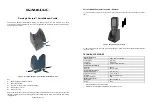
1.
First, insert 2 x AA, IEC LR6, 1.5V batteries into the Weather Station. Once the batteries are in place, all
segments of the LCD will light up briefly. Then the indoor temperature, the time as -:--, and the weather icons
sun and clouds will be displayed. If the indoor temperature is not displayed after a few seconds, remove the
batteries and wait for at least 30 seconds before reinserting them. Once the indoor data is displayed proceed to
step 2.
2.
Within 1-1/2 minutes of activating the Weather station, place 2 x AAA, IEC LR3, 1.5V batteries into the
transmitter.
3.
After a few seconds of inserting the batteries into the transmitter, the Weather Station will start receiving data
from the transmitter. The
remote temperature will then be displayed on the Weather Station. If this does not
happen after 2 minutes, the batteries will need to be removed from both units and reset from step 1.
4.
The Weather Station can take up to 3 remote transmitters. If you have purchased additional transmitters, follow
step 2 for all extra transmitters. However, ensure that you leave 10 seconds in between the reception of the
last transmitter and the set-up of the following transmitter. The Weather Station will number the transmitters in
the order of set-up, i.e. the first transmitter will have the temperature displayed with the channel number 1
against it and so on.
Note:
No channel number will show up if there is only one transmitter used.
5.
When all the transmitters are set up, there is a testing period, during which the display switches quickly
between all the received transmitters at random, according to which random transmission it receives. Pressing
any key will stop this process and the display will show the temperature for the first transmitter. The process
also stops automatically if no keys are pressed for a few minutes.
6.
The DCF-77 time code reception is automatically started just after the Weather Station is activated. This takes
typically between 3 - 5 minutes in good conditions. This time period is an excellent opportunity to locate the
transmitter(s) in suitable location(s) outdoors. In order to ensure sufficient 433 MHz transmission however, this
should under good conditions be no more than 20 - 25 meters from where the Weather Station will be finally
positioned (see notes on “
Positioning
” and “
433 MHz Reception
”).
7.
If after 10 minutes the DCF time has not been received, use the SET key to manually enter a time initially. The
clock will automatically attempt each hour to receive the DCF time. When this is successful, the received time
will override the manually set time.
Note:
Should the total time of inserting the batteries into the transmitters take longer than 1-1/2 minutes from the time of
inserting the batteries into the Weather Station then temperature reception problems may occur. If the temperature is
not being received, then see
Checking for 433 MHz reception
, before resetting the units (see
Resetting the
Weather Station
below).
In the event of changing batteries in any of the units, all units need to be reset by following the setting up procedures.
This is because the transmitter at start-up assigns a random security code and this code must be received and stored
by the Weather Station in the first 1-1/2 minutes of power being supplied to it.
BATTERY CHANGE:
It is recommended to replace the batteries in all units on an annual basis to ensure optimum accuracy of these units.
Please participate in the preservation of the environment. Return used batteries to an authorized
depot.
LCD SCREEN
The Weather Station’s LCD is split into 5 sections displaying the information for time, weather forecast, indoors and
outdoors.
All the segments will light up momentarily before displaying:
1. Weather
Icon
2.
Time “-:--“
3.
Indoor temperature in degree Celsius (°C)
4.
Hidden Max/Min icon for Indoor/Outdoor Temperature and Transmitter Identification Number
5.
Outdoor Temperature in °C

























